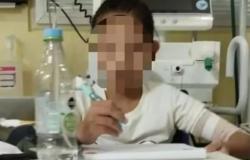
After several criminal acts with varying degrees of violence in which they were victims taxi driversthe drivers presented a petition in the Legislature of Mendoza demanding measures to combat unsafety. And although there was a quick response from the Ministry of Security and fixed and mobile controls will return, the measures seem not to be enough. MDZ got into a taxi to learn how the driver can take care of himself and what the response of the police officers is like.
According to Hugo, our driver, “going out into the street is walking with a lot of fear of not returning home,” while he assures that “today walking in the cab “It’s one of the most dangerous jobs there is.”
That phrase is consistent with the last episode that gained importance in the media. It was what happened near Campo Papa last Monday, where a 51-year-old driver was savagely hit in the head by a couple of criminals who were armed and even fired two shots.
The violet light and the panic button
Throughout the journey, the cabbie He showed us the panic button and the violet light that is an alarm signal for the Police. The first is key, “as long as it works, if not we are on the side of God,” she says, while the second deserves a separate paragraph.
While we were driving through the city, Hugo turned on the violet light, which is reflected on the roof, bumpers and sides of the vehicle. He even found a patrol car, so he began a mock call for help.
“Right now I have the violet light on. The driver of that cell phone that is coming behind us would have to turn on the siren, lock me in and let you down. Either he doesn’t know that that light is when someone is having a problem or is ignoring the situation, “He looks at us as if we were tourists. So sometimes you feel helpless,” he laments.
Then, he adds that this signal works through a panic button. Thus, “when the Police see the light, they have the obligation to stop us, because we are in a state in which we need to be controlled or assisted if it is an emergency case.”
Dangerous areas
Another major concern for drivers is the so-called “red zones.” This is how they identify some sectors of the department of Las Heras, the area west of Godoy Cruz, the lower part of Luján de Cuyo or Rodeo de la Cruz, in Guaymallén, to name a few examples.
Hugo tells us that he was a victim of illegal acts on several occasions and says that “there is no cabbie who has never been touched.” Then, he adds that “the worst was when I took a young man from the guard of a hospital to the La Estanzuela neighborhood. He was crying inconsolably as if a relative had died or something and before arriving he attacked me with a rock on the head, near the ear, and he stole some of my belongings. A Police Officer from the Command assisted me, they took me to a small room in La Estanzuela and from there they took me by ambulance to the Spanish Hospital. “I was hospitalized for three days for a head injury.”
When we were about to end the trip, we asked him what he would do if we asked him to change the destination to go to a dangerous place, something that usually happens: “in that case, can I pretend that the car breaks down or press the panic button so that “The police follow me and control me,” he said.
Finally at the destination, we ask the driver to wait for us to enter the editorial office to get the money to pay for the transfer. “They’re not going to come back with a gun, are they?” he replied. And that is another of the criminal strategies that they can sometimes face.





